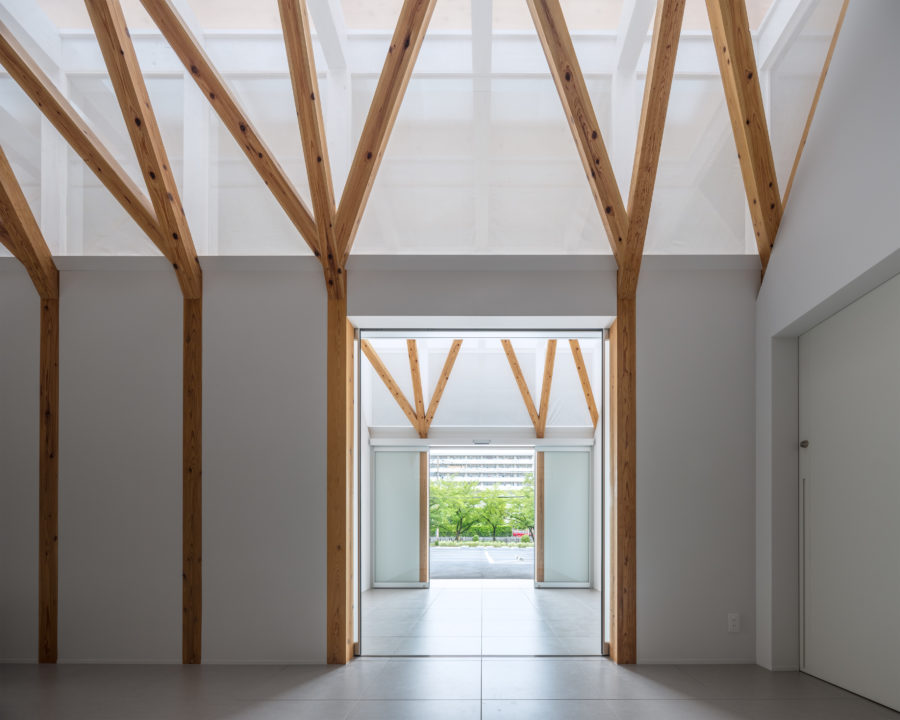9層の床をもつ「塔」と、半屋内的な「東屋」。2棟で1つの住宅である。
住宅の機能を担う棟は、建坪四畳半の「塔」。置くべき家具はすべて建築に埋め込んで効率的に凝縮し、段差は動線であり家具でもある状態とした。空間を組み立てるというよりはむしろ、家具を積み重ねてそれをよじ登って生活するような構成。身体スケールの設えが縦に展開していき、踊るようにシークエンスが体験される。ベンチ、テーブル、タンス、床の間の違い棚、ソファ、洗面台にそれぞれ足を掛けて登り、最上部の就寝地へいたるというように。
また、フットプリントをできるだけ小さくして敷地の外部をなるべく多く残すことで、単に生活を内部で完結させるのではなく、外部へも暮らしのアクティビティが広がっていくことを目指した。果実を収穫したり、子供と虫を探して遊んだりと、都市部の密集した住宅地ならば神経質にならざるを得ない屋外での過ごし方も、ここではさほど気にせず楽しむことができる。外に出ることで近所との交流の機会も多くなる。
一方「東屋」は、機能から削ぎ落とした余白の部分で、この住宅の面積の約7割がこの棟にある。大きく簡素で半屋外的に過ごせる居場所とした。街路からは東屋を通して森の中へ真っすぐに視線が抜けて、引き込まれるようなアプローチを意図した。近所の人がふらっと立ち寄り何気ない会話を交わす玄関先のようであり、人を招いてお茶をする応接間のようであり、家族や時には1人だけで過ごすリビングのような場所である。外周の半分を占める開口からは、風にしやなかに揺らめく木々の葉っぱだけが見え、ずっと眺めていられる。そんな大らかな開放性を備えた、街や森との関係を取りもつ余白空間である。
2つの棟は、それぞれまったく異なる性質をもちながら、1つの家として相互に補完し合う。どちらの棟も、柱梁は4寸角材のシンプルな軸組で、外壁は背後のスギ林に同調するスギ皮葺きとしている。2棟それぞれの構成要素はまったく同じだけれど、空間の用途や性質の差異により対比的なプロポーションを体現させている。(渡部光樹、渡部梨華)
A house consisting of a "tower" with layers of functions and a "pavilion" with liberating margins
The tower, which has nine floors, and the pavilion, which is semi-indoor, comprise a single house.
The tower, with a floor area of four and a half tatami mats, serves as the functional part of the house. All the furniture to be placed in the house is efficiently condensed by embedding it in the architecture, and the difference in level is both a line of flow and a piece of furniture. Rather than assembling the space, it comprises a stack of furniture, which is climbed up and lived in. The body-scale arrangement develops vertically, and the sequence is experienced as if dancing. The visitor climbs up the bench, table, chest of drawers, alcove shelf, sofa, and washbasin by hanging their feet on each and then climbs up to the sleeping area at the top of the space.
By keeping the footprint as small as possible and leaving as much of the site’s exterior as possible, we aimed to extend daily life activities to the outside, rather than simply completing life inside. Here, one can enjoy outdoor activities such as harvesting fruit or looking for insects with the children without worrying about how one would spend time outdoors, which would be a nervous habit in a dense urban residential area. Going outside also provides many opportunities for interaction with neighbors.
The “pavilion,” on the other hand, is a blank space stripped of functionality, and approximately 70% of the area of the house is in this wing. It is a large, simple, semi-outdoor place to spend time. The approach was intended to draw the eye straight into the forest from the street through the pavilion. It is like a front door where neighbors stop by for a casual conversation, a parlor inviting people for tea, and a living room where family and sometimes just one person spend time together. Through the opening that occupies half of the perimeter, one can see only the leaves of the trees swaying softly in the wind, and one can gaze at them all the time. It is a space with such a generous openness, a blank space that maintains a relationship with the city and the forest.
The house’s two wings are entirely different yet complement each other as a single house. Both wings have a simple 4″ square timber post-and-beam framework, and the exterior walls are clad in cedar bark, keeping with the cedar forest behind them. (Kouki Watanabe, Rika Watanabe)
【ダブルハウス】
所在地:秋田県秋田市
用途:戸建住宅
クライアント:個人
竣工:2021年
設計:W
担当:渡部光樹、渡部梨華
構造設計:円酒構造設計
施工:茂木建設
撮影:高野ユリカ
工事種別:新築
構造:木造
規模:地上3階+平屋
敷地面積:246.95m²
建築面積:61.10m²
延床面積:75m²
設計期間:2018.04-2021.02
施工期間:2021.03-2021.10
【Double House】
Location: Akita-shi, Akita, Japan
Principal use: Residence
Client: Individual
Completion: 2021
Architects: W
Design team: Kouki Watanabe, Rika Watanabe
Structure design: Enshu Structural Consultants
Construction: Mogi Kensetsu
Photographs: Yurika Kono
Construction type: New Building
Main structure: Wood
Building scale: 3 stories + 1 story
Site area: 246.95m²
Building area: 61.10m²
Total floor area: 75m²
Design term: 2018.04-2021.02
Construction term: 2021.03-2021.10








